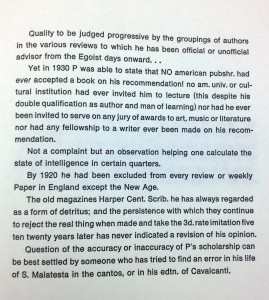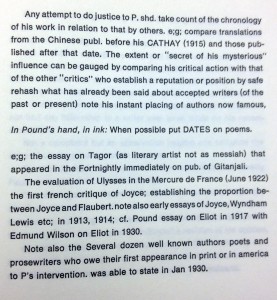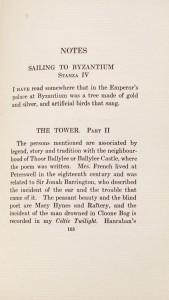Pound for Pound’s Sake
[Posted by Kiely MacMahon ’15, for Prof. David Rosen’s course, “Modern Poetry”]
 What did I find in the Watkinson? I found the 102nd copy of a 200-run printing of an Ezra Pound Autobiographical Outline from 1962. The “Outline” is Pound’s description of the events of his own life in ten pages of rice paper. He refers to himself in the third person throughout, either as “P” or “EP”.
What did I find in the Watkinson? I found the 102nd copy of a 200-run printing of an Ezra Pound Autobiographical Outline from 1962. The “Outline” is Pound’s description of the events of his own life in ten pages of rice paper. He refers to himself in the third person throughout, either as “P” or “EP”.
 Pound stresses the need for his work to be read chronologically, and for his poems to be listed with their years of publication. He also expresses a general disdain for the publishing industry. He is incredulous that “NO american pubshr. had ever accepted a book on his recommendation! no am. univ. or cultural institution had ever invited him to lecture (this despite his double qualification as author and man of learning)”. Thus, in order to thwart the industry, he finds a manner in which he can self-publish.
Pound stresses the need for his work to be read chronologically, and for his poems to be listed with their years of publication. He also expresses a general disdain for the publishing industry. He is incredulous that “NO american pubshr. had ever accepted a book on his recommendation! no am. univ. or cultural institution had ever invited him to lecture (this despite his double qualification as author and man of learning)”. Thus, in order to thwart the industry, he finds a manner in which he can self-publish.
What interests me the most, though, is why Pound decided to publish an Autobiographical Outline at all. Why would his work necessitate an “Outline”? Did he not think his work would stand alone? Is there a need for Pound to run through his life and catalog it? These pages are not notes on his work, but a way in which one can read more about Pound’s life. This is the Pound that Pound wanted to be known by. I’m also interested as to how the Watkinson acquired a copy, particularly since 26 copies of the 200 were reserved for “Nadja.” Nadja is listed alongside an address, as the only publishing information. The year of publication is listed in the Watkinson catalog but only “March” is given as to context on the Outline itself. Perhaps to Pound, the season, the month, held more weight than the year.
 Pound also stylistically abbreviates words, like “publisher” (“pubshr.”) and “should” (shd). He does credit himself within the Outline as the inventor of the words “Imagiste” and “Imagism” (“in order to avoid vain gabble as to the nature of poetry”), so I wonder if his preference for clarity and brevity is merely exemplified by his shortening of words in the text. Imagism does pride itself on precision. That said, the entire outline is only 10 pages long, and only 7 of those pages have any words on them.
Pound also stylistically abbreviates words, like “publisher” (“pubshr.”) and “should” (shd). He does credit himself within the Outline as the inventor of the words “Imagiste” and “Imagism” (“in order to avoid vain gabble as to the nature of poetry”), so I wonder if his preference for clarity and brevity is merely exemplified by his shortening of words in the text. Imagism does pride itself on precision. That said, the entire outline is only 10 pages long, and only 7 of those pages have any words on them.
The physical object of the outline is striking, also, because not only is the cover of the Outline purple rice paper, but the “Nadja” publishing information is printed in purple ink. The rest of the piece is printed in black. Having read T.S. Eliot’s “The Waste Land” transcript with Pound and Vivien Eliot’s notes, Pound occasionally used a purple crayon but I wonder if there was some inherent preference throughout his editing or self-editing life for the purple that resulted in the paper and ink choices.
 Pound describes the intricacies of his life as if they were someone else’s, “P”’s. He lists his accomplishments in a removed manner, but proceeds to credit himself throughout. Pound takes his own narrative, and tries to have his way with it. I was looking for some physical Pound-evidence in the Watkinson, preferably of the signature variety, but I find I am not disappointed. I did want to find something specifically his, and I have not failed in that endeavor. This small-run only had 200 copies printed, ever, in the whole world, and the physicality of the print and the paper speaks directly to Pound. It is not just his words, but also the way in which he presents them, that markedly links him to his work.
Pound describes the intricacies of his life as if they were someone else’s, “P”’s. He lists his accomplishments in a removed manner, but proceeds to credit himself throughout. Pound takes his own narrative, and tries to have his way with it. I was looking for some physical Pound-evidence in the Watkinson, preferably of the signature variety, but I find I am not disappointed. I did want to find something specifically his, and I have not failed in that endeavor. This small-run only had 200 copies printed, ever, in the whole world, and the physicality of the print and the paper speaks directly to Pound. It is not just his words, but also the way in which he presents them, that markedly links him to his work.








